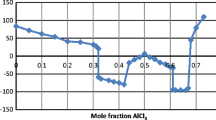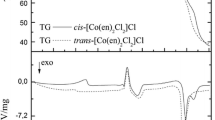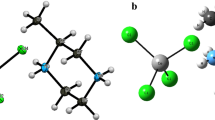Abstract
The second-order electron transfer reaction between the photo-excited triplet state of [Zn(TPP)]* (TPP = 5,10,15,20-tetraphenylporphyrin) and [Co(sep)]3+ (sep = sepulchrate = 1,3,6,8,10,13,16,19-octaazabicyclo[6.6.6]eicosane) was investigated in three ionic liquids (ILs, 1-R-3-methylimidazolium bis(trifluoromethylsulfonyl)imide with R = butyl, pentyl, and hexyl) and in acetonitrile. Results of electrochemical and kinetic measurements indicated that ILs dissociate in the vicinity of charged metal complexes and at electrodes, although the dissociated anionic and cationic components of the ILs seem to exist as pairs around the metal complexes. Second-order rate constants for the electron transfer reaction are 1.88 × 109, 3.65 × 107, 2.63 × 107, and 2.01 × 107 kg·mol−1·s−1 in acetonitrile and in the butyl, pentyl and hexyl ILs, respectively, at 298 K, after correction of the contribution of diffusion. The average slope of the plot of the logarithmic second-order rate constants observed in acetonitrile and ILs against the logarithmic viscosity of each solvent was − 0.84. However, the slope of the same plot was much steeper (− 4.1) when data for only the three ILs were used. Detailed analyses of the experimental results on the basis of the Latner–Levin cross relation and the Marcus theory lead to the conclusion that the solvent properties such as the dielectric constant and refractive index around the polarized/charged transition states are different from those for the bulk ILs: observed self-exchange rate constants did not exhibit the Pekar factor dependence when dielectric constants and refractive indices for bulk ILs are used.











Similar content being viewed by others
Notes
These reaction curves can be attributed to consecutive reactions:
\( {\text{A}}_{1} \to {\text{A}}_{2} \to {\text{A}}_{3}.\)
The absorbance of the reacting solution, A, can be expressed as
\( A = P\exp({-}k_{1} t) + Q\exp({-}k_{2} t) + R \), where the terms P, Q, and R are functions of the rate constants (k1 and k2), molar absorption coefficients of each species, and the initial concentrations of A1 and A2. This expression is well documented in many textbooks for chemical kinetics such as [49].
References
Baba, K., Ono, H., Itoh, E., Itoh, S., Noda, K., Usui, T., Ishihara, K., Inamo, M., Takagi, H.D., Asano, T.: Kinetic study of thermal Z to E isomerization reactions of azobenzene and 4-dimethylamino-4′-nitroazobenzene in ionic liquids [1-R-3-methylimidazolium bis(trifluoromethylsulfonyl)imide with R = butyl, pentyl, and hexyl]. Chem. Eur. J. 12, 5328–5333 (2006)
Sutin, N.: Theory of electron-transfer reactions—insights and hindsights. Progr. Inorg. Chem. 30, 441–499 (1983)
Cannon, R.D.: Electron Transfer Reactions. Butterworth, London (1980)
Marcus, R.A.: On the theory of electron-transfer reactions. VI. Unified treatment for homogeneous and electrode reactions. J. Chem. Phys. 43, 679–701 (1965)
Swaddle, T.W.: “Pressure-testing” Marcus-Hush theories of outer-sphere electron-transfer kinetics. Inorg. Chem. 29, 5017–5025 (1990)
Takagi, H.D., Swaddle, T.W.: Estimation of the outer-sphere contribution to the activation volume for electron exchange reactions using the mean spherical approximation. Chem. Phys. Lett. 248, 207–212 (1996)
Weaver, M.: Dynamical solvent effects on activated electron-transfer reactions: principles, pitfalls, and progress. Chem. Rev. 92, 463–480 (1992)
Grampp, G., Jaenicke, W.: Kinetics of diabatic and adiabatic electron exchange in organic systems comparison of theory and experiment. Ber. Bunsenges. 95, 904–927 (1991)
Rosokha, S.V., Newton, M.D., Head-Gordon, M., Kochi, J.K.: Mulliken-Hush elucidation of the encounter (precursor) complex in intermolecular electron transfer via self-exchange of tetracyanoethylene anion-radical. Chem. Phys. 324, 117–128 (2006)
Fawcett, W.R., Opallo, M.: The kinetics of heterogeneous electron transfer reaction in polar solvents. Angew. Chem. 33, 2131–2143 (1994)
Paul, A., Samanta, A.: Photoinduced electron transfer reaction in room temperature ionic liquids: a combined laser flash photolysis and fluorescence study. J. Phys. Chem. B 111, 1957–1962 (2007)
Skrzypczak, A., Neta, P.: Diffusion-controlled electron-transfer reactions in ionic liquids. J. Phys. Chem. A 107, 7800–7803 (2003)
Vieira, R.C., Falvey, D.E.: Photoinduced electron-transfer reactions in two room-temperature ionic liquids: 1-butyl-3-methylimidazolium hexafluorophosphate and 1-octyl-3-methylimidazolium hexafluorophosphate. J. Phys. Chem. B 111, 5023–5029 (2007)
Bentley, C.L., Li, J., Bond, A.M., Zang, J.: Mass-transport and heterogeneous electron-transfer kinetics associated with the ferrocene/ferrocenium process in ionic liquids. J. Phys. Chem. C 120, 16516–16525 (2016)
Fujita, K., Kuwahara, J., Nakamura, N., Ohno, H.: Communication—fast electron transfer reaction of azurin fixed on the modified electrode in hydrated ionic liquids. J. Electrochem. Soc. 163, G79–G81 (2016)
Barrado, E., Rodriguez, J.A., Hernandez, P., Castrillejo, Y.: Electrochemical behavior of copper species in the 1-buthyl-3-methyl-imidazolium chloride (BMIMCl) ionic liquid on a Pt electrode. J. Electroanal. Chem. 768, 89–101 (2016)
Mladenova, B.Y., Kattnig, D.R., Sudy, B., Chotoc, P., Grampp, G.: Are the current theories of electron transfer applicable to reactions in ionic liquids? An ESR-study on the TCNE/TCNE−˙ couple. Phys. Chem. Chem. Phys. 18, 14442–14448 (2016)
Belding, S.R., Rees, N.V., Aldous, L., Hardacre, C., Compton, R.G.: Behavior of the heterogeneous electron-transfer rate constants of arenes and substituted anthracenes in room-temperature ionic liquids. J. Phys. Chem. C 112, 1650–1657 (2008)
Koch, M., Rosspeintner, A., Angulo, G., Vauthey, E.: Bimolecular photoinduced electron transfer in imidazolium-based room-temperature ionic liquids is not faster than in conventional solvents. J. Am. Chem. Soc. 134, 3729–3736 (2012)
Liang, M., Kaintz, A., Baker, G.A., Marconcelli, M.: Bimolecular electron transfer in ionic liquids: are reaction rates anomalously high? J. Phys. Chem. B 116, 1370–1384 (2012)
Creaser, I.I., Harrowfield, J.M., Herlt, A.J., Sargeson, A.M., Springborg, J., Geue, R.J., Snow, M.R.: Sepulchrate: a macrobicyclic nitrogen cage for metal ions. J. Am. Chem. Soc. 99, 3181–3182 (1977)
Ratner, M.A., Levin, R.D.: A thermodynamic derivation of the cross-relations for rates of electron-transfer reactions. J. Am. Chem. Soc. 102, 4898–4900 (1980)
Jordan, R.B.: Reaction Mechanisms of Inorganic and Organometallic Systems. Oxford University Press, Oxford (1998)
Yamada, A., Mabe, T., Yamane, R., Noda, K., Wasada, Y., Inamo, M., Ishihara, K., Suzuki, T., Takagi, H.D.: Flipping of the coordinated triazine moiety in Cu(I)–L2 and the small electronic factor, κel, for direct outer-sphere cross reactions: syntheses, crystal structures and redox behaviour of copper(II)/(I)–L2 complexes (L = 3-(2-pyridyl)-5,6-diphenyl-1,2,4-triazine). Dalton Trans. 44, 13979–13990 (2015)
Bonhøte, P., Dias, A.-P., Papageorgiou, N., Kalyanasundaram, K., Gråtzel, M.: Hydrophobic, highly conductive ambient-temperature molten salts. Inorg. Chem. 35, 1168–1178 (1996)
Dyson, P.J., Grossel, M.C., Srinivasan, N., Vine, T., Welton, T., Williams, D.J., White, A.J.P., Zigras, T.: Organometallic synthesis in ambient temperature chloroaluminate(III) ionic liquids. Ligand exchange reactions of ferrocene. J. Chem. Soc. Dalton Trans. 19, 3465–3469 (1997)
Iijima, K.: Problems in analyzing metal complexes with fluorine. Technical Reports, Faculty of Science, Osaka University. 20, 17–19 (2011)
Gabbie, M.A., Valtiner, M., Banquy, X., Fox, E.T., Henderson, W.A., Israelachvili, J.N.: Ionic liquids behave as dilute electrolyte solutions. Proc. Nat. Acad. Sci. USA 110, 9674–9679 (2013)
Bard, A.J., Falkner, L.R.: Electrochemical Method. Wiley, New York (1980)
Seybold, P.G., Gouterman, M.: Porphyrins: XIII: Fluorescence spectra and quantum yields. J. Molec. Spectrosc. 31, 1–13 (1969)
Gradyushko, A.T., Tsvirko, M.P.: Probabilities of inter-combination transitions in porphyrin and metalloporphyrin molecules. Opt. Spektrosc. 31, 548–556 (1971)
Quimby, D.J., Longo, F.R.: Luminescence studies on several tetraarylporphins and their zinc derivatives. J. Am. Chem. Soc. 97, 5111–5117 (1975)
Harriman, A.: Luminescence of porphyrins and metalloporphyrins. Part 1. Zinc(II), nickel(II) and manganese(II) porphyrins. J. Chem. Soc. Faraday. Trans. I 76, 1978–1985 (1980)
Lukaszewicz, A., Karolczak, J., Kowalska, D., Maciejewski, A., Ziolek, M., Steer, R.P.: Photophysical processes in electronic states of zinc tetraphenyl porphyrin accessed on one- and two-photon excitation in the Soret region. Chem. Phys. 331, 359–372 (2007)
Politis, T.G., Drickamer, H.G.: High pressure luminescence studies of metalloporphyrins in polymeric media. J. Chem. Phys. 74, 263–272 (1981)
Wolynes, P.G.: Linearized microscopic theories of nonequilibrium solvation. J. Chem. Phys. 86, 5133–5136 (1987)
Rips, I., Klafter, J., Jortner, J.: Dynamics of ionic solvation. J. Chem. Phys. 88, 3246–3252 (1988)
McManis, G.E., Weaver, M.J.: Solvent dynamical effects in electron transfer: numerical predictions of molecularity effects using the mean spherical approximation. J. Chem. Phys. 90, 1720–1729 (1989)
McManis, G.E., Gochev, A., Nielson, R.M., Weaver, M.J.: Solvent effects on intervalence electron-transfer energies for biferrocene cations: comparisons with molecular models of solvent reorganization. J. Phys. Chem. 93, 7733–7739 (1989)
Faucett, W.R., Blum, L.: Estimation of the outer-sphere contribution to the activation parameters for homogeneous electron-transfer reactions using the mean spherical approximation. Chem. Phys. Lett. 187, 173–179 (1991)
Matsumoto, M., Tarumi, T., Takahashi, I., Noda, T., Takagi, H.D.: Pressure dependence of the electrode potentials of some iron(III/II), cobalt(III/II), and Ni(III/II) couples in aqueous solution: Estimation of the reaction volumes for M(III)/M(II) couples. Z. Naturforch. 52b, 1087–1093 (1997)
Daguenet, C., Dyson, P.J., Krossing, I., Oleinikova, A., Slattery, J., Wakai, C., Weinga, H.: Dielectric response of imidazolium-based room-temperature ionic liquids. J. Phys. Chem. B 110, 12682–12688 (2006)
Nakamura, K., Shikata, T.: Systematic dielectric and NMR study of the ionic liquid 1-alkyl-3-methyl imidazolium. ChemPhysChem 11, 285–294 (2010)
Rodriguez, J., Kirmaier, C., Holton, D.: Optical properties of metalloporphyrin excited states. J. Am. Chem. Soc. 111, 6500–6506 (1989)
Fajer, J., Borg, D.C., Forman, A., Folton, R.H.: π-Cation radicals and dications of metalloporphyrins. J. Am. Chem. Soc. 92, 3451–3459 (1970)
Sakuma, T., Ohta, T., Yagyu, T., Takagi, H.D., Inamo, M.: Copper(II)-assisted charge transfer quenching of the excited state of a zinc(II) porphyrin complex bearing a peripheral bipyridine moiety. Inorg. Chem. Commun. 38, 108–111 (2013)
Aoki, K., Goshima, T., Kozuka, Y., Kawamori, Y., Ono, N., Hisaeda, Y., Takagi, H.D., Inamo, M.: Electron transfer reaction of porphyrin and porphycene complexes of Cu(II) and Zn(II) in acetonitrile. Dalton Trans. 0, 119–125 (2009)
Luo, C., Guldi, D.M., Imahori, H., Tamaki, K., Sakata, Y.: Sequential energy and electron transfer in an artificial reaction center: formation of a long-lived charge-separated state. J. Am. Chem. Soc. 122, 6535–6551 (2000)
Moore, J.W., Pearson, R.G.: Kinetics and Mechanism, 3rd edn, p. 290. Wiley, New York (1981)
Noyes, R.M.: Reaction Kinetics. In: Porter, G. (ed.) Progr. Pergamon Press, London (1961)
North, A.M.: The Collison Theory of Chemical Reactions in Liquids. Methuen, London (1964)
Doine, H., Swaddle, T.W.: Pressure effects on the self-exchange rates of cobalt(III/II) couples: evidence for adiabatic electron transfer in the bis(1,4,7-trithiacyclononane) and sepulchrate complexes. Inorg. Chem. 30, 1858–1862 (1991)
Logan, S.R.: Effects of temperature on the rates of diffusion-controlled reactions. Trans. Faraday Soc. 63, 1712–1719 (1967)
Weston, R.E., Schwarz, H.A.: Chemical Kinetics. Prentice-Hall, New Jersey (1972)
Sumi, H., Marcus, R.A.: Dynamical effects in electron transfer reactions. J. Chem. Phys. 84, 4894–4914 (1986)
Sumi, H.: Theory on reaction rates in nonthermalized steady states during conformational fluctuations in viscous solvents. J. Phys. Chem. 95, 3334–3350 (1991)
Hanggi, P., Borkovec, M.: Reaction-rate theory: 50 years after Kramers. Rev. Modern Phys. 62, 251–341 (1990)
Kramers, H.A.: Brownian motion in a field of force and the diffusion model of chemical reactions. Physica 7, 284–304 (1940)
Zahir, K., Espenson, J.H., Bakac, A.: Reactions of polypyridylchromium(II) ions with oxygen: determination of the self-exchange rate constant of oxygen O2/O2O2 −.O2 −. J. Am. Chem. Soc. 110, 5059–5063 (1988)
Grace, M.R., Takagi, H.D., Swaddle, T.W.: A cross relation in volumes of activation for electron-transfer reactions. Inorg. Chem. 33, 1915–1920 (1994)
Fawcett, W.R., Gaa´l, A., Misicak, D.: Estimation of the rate constant for electron transfer in room temperature ionic liquids. J. Electroanal. Chem. 660, 230–233 (2011)
Grampp, G., Harrer, W., Jaenicke, W.: The role of solvent reorganization dynamics in homogeneous electron self-exchange reactions. J. Chem. Soc. Faraday Trans. I 1(83), 161–166 (1987)
Hamaguchi, H., Ozawa, R.: Structure of ionic liquids and ionic liquid compounds: are ionic liquids genuine liquids in the conventional sense? Adv. Chem. Phys. 131, 85–104 (2005)
Xiao, T., Song, X.: Reorganization energy of electron transfer processes in ionic fluids: a molecular Debye-Hückel approach. J. Chem. Phys. 138, 114105–114112 (2013)
Kornyshev, A.A.: Non-local dielectric response of a polar solvent and Debye screening in ionic solution. J. Chem. Soc. Faraday Trans. II 79, 651–661 (1983)
Acknowledgements
We wish to thank JSPS KAKENHI Grant Numbers 16K05865 and 15K05451for financial support.
Author information
Authors and Affiliations
Corresponding authors
Appendices
Appendix 1
Table 6 presents the Zij values calculated by assuming a couple of plausible dielectric constants εD for ILs as solvents (see text). It is obvious that the diffusion rate constant, ZAA, is very small when cobalt complexes exist in solutions with formal charges. As the inner-sphere activation energy for the [Co(sep)]3+/2+ couple is close to 40 kJ·mol−1, the diffusion controlled rate constant has to be > 1 × 108 kg·mol−1·s−1 to reproduce the exchange rate constant of ca. 5.1 kg·mol−1·s−1. However, the ZAA values are still smaller than 107 kg·mol−1·s−1, even when the charges on the complexes are +1. Therefore, we may safely conclude that the assumption ZAB/ZAA ZBB = 1 is valid and the cobalt complexes are fully associated with the counter anions in ILs (at least the formal charges on either Co(III) or Co(II) complexes are completely cancelled). Note that the pair of a cation and an anion with the charge product of − 3 is almost fully ion paired in solvents with εD < 30 [23].
Appendix 2
Several previous articles offered new ideas concerning the modification of theoretical equations for dielectric properties of ILs on the basis of the non-linear response of solvents [64, 65]. Grampp and co-workers examined these new ideas by applying them to their experimental results for the self-exchange reaction of the TCNE0/·− couple in various ILs, and clearly concluded that none of these theories reproduced their experimental observations [17].
We attempted to re-calculate the values of the Pekar factors for BMIM and HMIM using the experimental results reported by Grampp and co-workers: the outer-sphere activation Gibbs energy for the TCNE0/·− self-exchange reaction was obtained by subtracting the estimated inner-sphere activation energy (3.25 kJ·mol−1) from each total activation energy for the reported second-order rate constants observed in BMIM and HMIM. Grampp and co-workers used an experimentally estimated value of the geometry function, that corresponds to ca. 510 pm for the radii of the TCNE and its anionic radical. As Eq. 15 and therefore the Pekar factor are very sensitive to the radii of reaction pairs, estimated Pekar factors were too large to be rationalized by any theories.
We found the experimentally obtained outer-sphere contribution to the activation Gibbs energies by Grampp and co-workers were reproduced when the radii of these species are 290–320 pm. Moreover, their experimental results are well reproduced when the Pekar factor for the reaction in HMIM is larger than that for the reaction in BMIM. This tendency is consistent with that observed in this study. Therefore, we conclude that modern theories [64, 65] cannot explain the experimental results reported by Grampp and co-workers nor the results obtained in this study. Note that our previous attempt to examine the contribution of the non-linear response of solvents to the outer-sphere electron transfer processes was not successful either, when self-exchange processes of metal complexes were examined in conventional molecular solvents [6].
We presume that the model proposed in this article, which is related to the modification of the solvent properties of ILs in the vicinity of charged precursor/successor complex because of the induced dissociation of ILs, is the most promising at this moment, at least when the classical/semi-classical treatment for the electron transfer reactions are employed [2,3,4].
In 2010 [43], Nakamura and Shikata investigated the dielectric constants of various ILs and found there are three regimes of dielectric relaxations, two of which are in the Debye regime: one corresponds to τ2 in the following equation and was attributed to the rotational relaxation of elongated IL involving free rotation of the cationic component.
where \( \varepsilon^{\prime} \) and \( \varepsilon^{\prime\prime} \) are the in-phase and the out-of-phase components of dielectric responses, and at the limit of \( \overline{\omega } = 0,\,\varepsilon_{s} = \varepsilon_{1} + \varepsilon_{2} + \varepsilon_{3} + \varepsilon_{\infty } \) (α indicates the slowest response τ3 is in the Cole–Cole regime). Nakamura and Shikata analyzed their results and concluded that (1) in the dissociated pair of ILs cationic components freely rotate and the distance between the cationic and anionic pair depended on the length of the substituents on the cationic component, (2) the dielectric constant of ILs increased with increasing the length of the substituents, and (3) the relaxation time was longer for the ILs with longer substituents on the cationic component for such dissociated pairs.
Although Nakamura and Shikata seem to believe the observed phenomena are related to the properties of the bulk ILs, it is clear that they observed properties of ILs in the vicinity of the electrodes (Israelachvili and co-workers [28] concluded that dissociation of ILs in the bulk is less than 0.1%).
In this study, we observed a similar increase of the dielectric constant in the vicinity of the transition state of homogeneous outer-sphere electron transfer reactions: the increase in the Pekar factor was in the order of the substituents on the imidazolium cation, BMIM < PMIM < HMIM. In addition, we already reported similar dependence of the activation energy on the length of substituents for the homogeneous first-order thermal isomerization reactions of substituted azobenzene with polar transition state [1].
Therefore, it is certain that the distances between the cationic and anionic components of ILs elongate because of the dissociation of ILs in the vicinity of charged/polarized species (in homogeneous solutions), and the dielectric constant of the ILs in the vicinity of charged/polarized species increases with increasing length of the substituents on the imidazolium cation of the ILs.
Rights and permissions
About this article
Cite this article
Mabe, T., Doseki, F., Yagyu, T. et al. Behavior of Ionic Liquids Around Charged Metal Complexes: Investigation of Homogeneous Electron Transfer Reactions Between Metal Complexes in Ionic Liquids. J Solution Chem 47, 993–1020 (2018). https://doi.org/10.1007/s10953-018-0772-6
Received:
Accepted:
Published:
Issue Date:
DOI: https://doi.org/10.1007/s10953-018-0772-6




